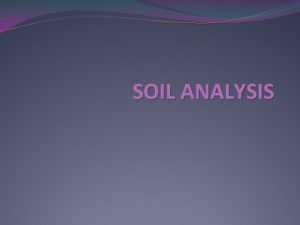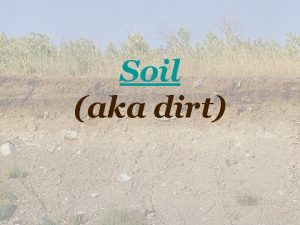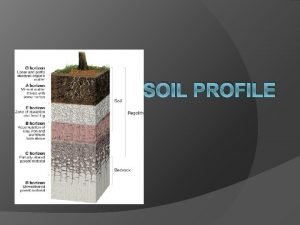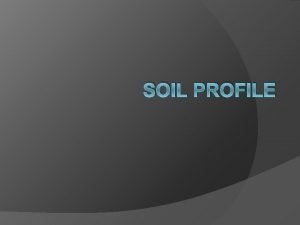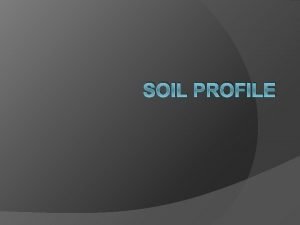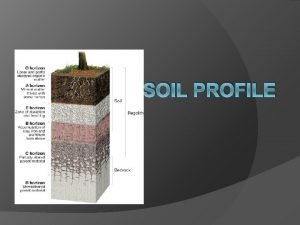What is soil Soil is the top layer









- Slides: 9

What is soil? Soil is the top layer of the Earth which we mostly think of as where grass, flowers, trees and crops grow. It is a mixture of different components like tiny pieces of rock particles, clay and decaying organic material (like dead plants and animals, leaf litter and poo). There are many different types of soil and this mainly depends on how much of the different components are there, the climate, how well it is looked after by humans and by the plants, animals and microbes living and growing on and in them. Different organisms prefer different soil environments; for example fruit trees love growing in soil that has lots of clay but carrots really don’t like that type of soil. Generally though, the more organic material a soil has the better because organic material has lots of nutrients that are helpful for the organisms living there. Let’s go on a soil safari and find out what organisms we will find……

Plants First on the soil safari we meet plants. We see all different types of plants around us all of the time; pretty flowers in the garden and fields, gigantic trees in forests, huge fields of crops in farms and even little herbs in pots in the kitchen. Different types of plants live in different types of soil and, generally, the more organic content and nutrients a soil has the better it will grow. Plants have special relationships with a lot of the other organisms in soil and work as a team with some of them (called symbiosis). Plants can release chemicals from their roots called exudates, some of these are sugars and acids which other organisms, like bacteria, love to eat. In turn, some of these organisms help plants to get nutrients from the soil, such as phosphate that plants need but can’t get on their own. Some Plants also shed old cells from their roots and old leaves which get broken down in the soil by decomposer organisms which add nutrition to the soil.

Bacteria On our next stop we zoom in on Bacteria are tiny organisms that you can only see with a microscope, there are thousands of different species and in just 1 g of soil there can be as many as 10 million of them! Bacteria live in all areas of soil but really like living around the roots of plants because plants roots release sugars and other nice things in to the soil that the bacteria like to eat. In return bacteria do some really helpful jobs for the plant like help it to defend against organisms that can make it sick (pathogens) or to help it get nutrients like nitrogen or phosphate that a plant needs but can’t get on its own. Bacteria also interact with other soil organisms like mycorrhizal fungi, nematodes and viruses. You’ll find out how they do that further on in the safari.

Decomposer Fungi Decomposer As we continue through the soil we meet a decomposer fungi. These can be called a Fungi few different things, in science we often call them saprotrophs but in day to day life you probably know them best as mushrooms. #Random. Fact the mushroom is actually the fruit of this fungi. and the rest of it is deep underground, spread out far through the soil in large networks. Decomposer fungi are incredibly important in soil because they break down organic matter like leaf litter, poo and dead organisms, releasing their nutrients such as carbon and nitrogen back in to the soil. These can then be used as food by plants and other soil microorganisms. This process is called decomposition and without it our soils would soon run out of nutrients meaning that the plants that we rely on for food (whether we eat them or they are fed to animals we eat) would be unable to grow and we would run out of food. Put simply, without mushrooms life on Earth would be very tough so even if you don’t like to eat mushrooms, remember that they are soil superheroes.

Nematodes Next we see a nematode wiggle past! Nematodes are very long, thin worms that range from being around as thick as a human hair to being 10 times thinner! They also vary quite a lot in length, some are so tiny you can only see them with a microscope whilst others can be as long as 1 meter! Some nematodes are considered to be pests because they eat plants but many species of nematode are very helpful for the soil and plants! This is because nematodes transport the bacteria that live on their body and inside their gut through soil and around the roots of plants, many of these bacteria perform helpful jobs for plants and other soil organisms. Nematodes are also helpful because they kill pests like slugs that can seriously damage crops.

M. Fungi Is that a net or a web we have just passed? No! it’s some M. fungi actually have a really long name which is mycorrhizal fungi, you can call this one Mike for short if you like. Not only does Mike have a really long name, Mike also has really long thin growths called hyphae. These hyphae can grow for miles and form a huge network, almost like a giant underground web. These hyphae can ether wrap themselves around the roots of a plant or even grow directly into the plants roots. The fungi get nutrients like sugar from the plants roots through their hyphae and in return they transport nutrients along their miles of hyphae, (distances a plants roots can’t possibly grow) directly to the plant. They’re a bit like a food delivery service for plants! The relationship with plants and mycorrhizal fungi has been going on from as far back as scientists can see, we even think that these special fungi were used by the very first plants that didn’t have their own proper roots, they used the fungi to transport nutrients instead. #Random. Fact They get the name mycorrhizal fungi because in Greek it means root fungus.

Algae As we explore the surface of the soil look who we meet. Algae are found in lots of different environments from lakes to rocks but they really like to grow in warm soil that has lots of moisture. They use light from the sun to make their own food, this is called photosynthesis, and it’s the same way that plants make their food too. Algae normally grow on the surface of soil so that they get plenty of sunlight but some can move around and bury themselves down, they can also get carried deep down in to the soil by earthworms. When algae die or dry up they form a crust on top of soil which helps to protect it from damage from weather called erosion. They also stabilise the soil, holding it together. Another fantastic thing that algae do for soil is add a lot of nutrients to it that they build up through photosynthesis, these nutrients are a great food source for plants, bacteria and other soil creatures.

Viruses get a bit of a bad reputation because they can make plants, animals, insects and other organisms like bacteria and fungi very sick. There are different types of viruses, one type is a phage. A phage infects bacteria by attaching itself to the bacteria and injecting its genes inside. The virus then uses the bacterias “organs” (which we call organelles) to make thousands of copies of itself until the bacteria gets completely filled up and eventually bursts! When the bacteria bursts open it releases all of the viruses that were inside and they can go on to infect other bacteria. We learned earlier that some bacteria and fungi can do helpful jobs for plants but not all bacteria and fungi are helpful, some can make plants sick too so viruses can be helpful if they infect bacteria or fungi that would otherwise kill other soil organisms. = Oh No! Rodney the Bacillus has a viral infection!

Glossary Cell A cell is the smallest biological unit that contains everything needed to be able to live on it’s own. Some organisms are a single cell, like bacteria. Other organisms, like plants and humans are made up of billions of cells. Component One part of a whole thing, for example, flour is a component of a cake. Decay To rot or to breakdown, for example when left over food turns to compost over time. Environment Everything around us, including air, soil, water, plants and animals. Exudates All of the different chemicals that a plant releases from its roots like sugars. Microorganism Living things that are so small they can only be seen with a microscope. Bacteria, fungi, viruses and algae are all examples of microorganisms. Nutrients Something that is needed for an organism to grown and stay healthy, for example fruit and vegetables in the human diet provide a lot of nutrients. Organic material The result of the decay of a dead organism Organism Any living thing Pathogen Any organism that can cause disease Symbiosis A close and long term relationship between two different organisms Species A group of similar organisms that can reproduce. As humans we are a species, so are dogs and so are carrots
 Top layer soil
Top layer soil Layer 6 presentation layer
Layer 6 presentation layer Layer 2 e layer 3
Layer 2 e layer 3 Pigmented layer and neural layer
Pigmented layer and neural layer Secure socket layer and transport layer security
Secure socket layer and transport layer security Layer-by-layer assembly
Layer-by-layer assembly Path of food from mouth to anus
Path of food from mouth to anus Secure socket layer and transport layer security
Secure socket layer and transport layer security Layer 2 vs layer 3 bitstream
Layer 2 vs layer 3 bitstream Secure socket layer and transport layer security
Secure socket layer and transport layer security
